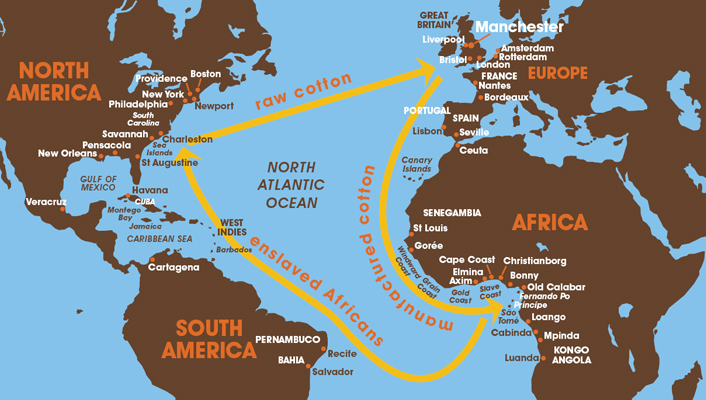In Greater Manchester
- How money from slavery made Greater Manchester
- The importance of cotton in north west England
- The Lancashire cotton famine
- Smoking, drinking and the British sweet tooth
- Black presence in Britain and north west England
- Resistance and campaigns for abolition
- The bicentenary of British abolition
Global
Africa, the arrival of Europeans and the transatlantic slave trade
Commerce and collecting
An extract from the Trade and Empire exhibition at The Whitworth Art Gallery
Slave-grown cotton is key to the story of the Industrial Revolution and to the accumulation of wealth that built Manchester during the eighteenth and nineteenth centuries. Every ounce of cotton in Britain was imported from overseas plantations, many of which used enslaved labour.
During the eighteenth century the slave plantations of the West Indies provided Manchester with raw cotton alongside the traditional sources of the Middle East and India. From 1790 this shifted to a dependence on the slave plantations of the American south and by 1802 America had become the largest supplier of cotton to the British market.
Slavery continued in North America after the abolition of the British slave trade in 1807 and Manchester remained dependent on slave-grown cotton. As late as 1860 America supplied 88% of the cotton imported into Britain. Slavery enabled cotton to be grown cheaply and was a major reason why the price of cotton textiles fell steadily from the 1790s to 1840.
During the eighteenth and nineteenth centuries new generations of rich industrialists and other businessmen emerged whose wealth derived from businesses associated with cotton. These families used some of this wealth to make collections of fine and decorative art to demonstrate their prestige, refinement and taste.

This map shows the major trade routes operating between Europe, Africa and the Americas, moving enslaved peoples, raw cotton and manufactured goods between the three continents. During the eighteenth and early nineteenth centuries the shape of these trade routes was roughly triangular.
Cotton was crucial to the rise of industrial Manchester but at what cost? An estimated 12 million Africans were forcefully transported across the Atlantic into slavery. Enslaved people were denied basic human rights and the inhumane treatment experienced on slave ships and plantations cost many their lives.
In Manchester, the rise of the cotton industry meant that the population of the city spiralled; multiplying from 17,000 to 180,000 between 1760 and 1830. Living and working conditions were crowded, dirty and dangerous. Whilst some grew very rich through cotton, it caused great deprivation and hardship for many more.
